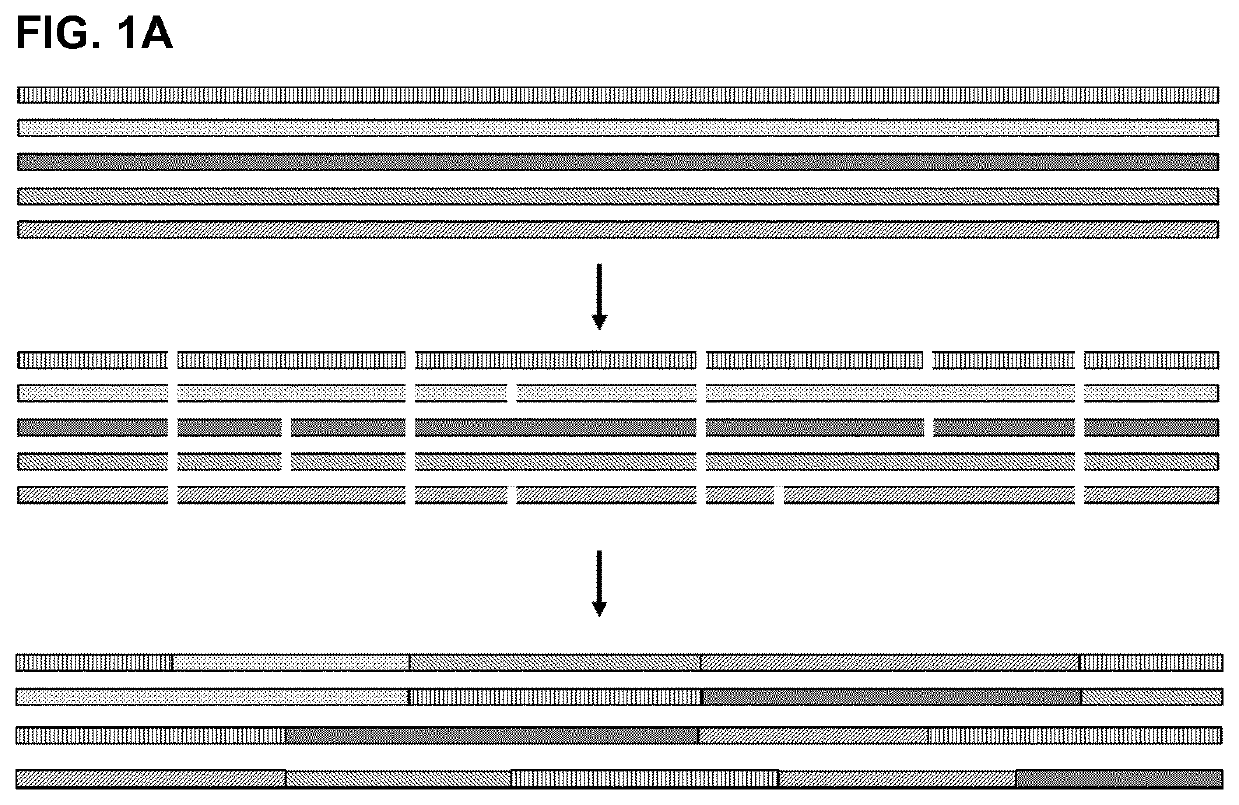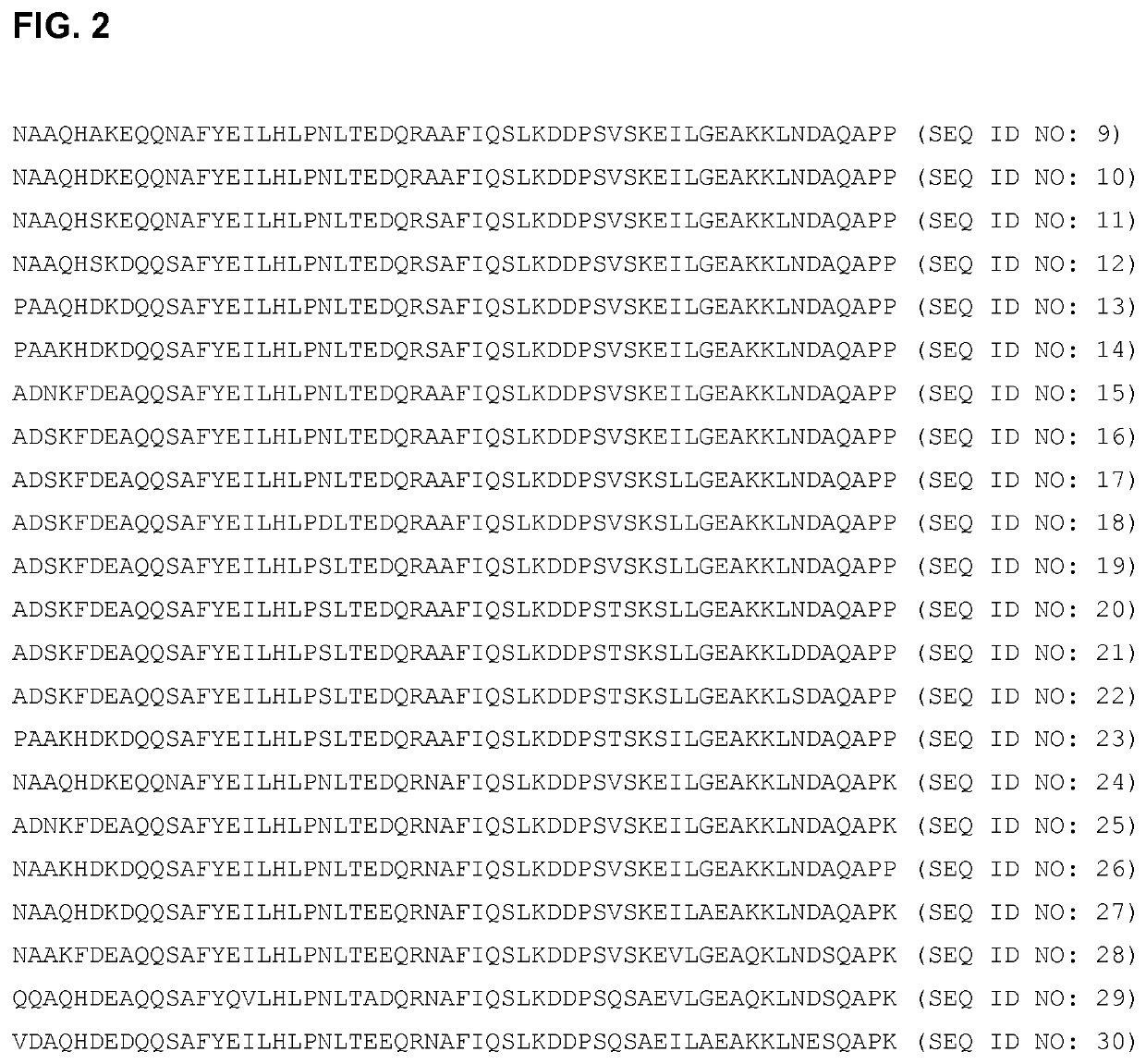Immunoglobulin-binding proteins and their use in affinity purification
a technology of immunoglobulin and binding proteins, applied in the field of non-natural binding proteins, can solve the problems of immunoglobulin-based chromatography matrices showing a loss of binding capacity
- Summary
- Abstract
- Description
- Claims
- Application Information
AI Technical Summary
Problems solved by technology
Method used
Image
Examples
example 1
n of IgG Binding Proteins of the Invention by a Shuffling Process
[0119]The IgG binding proteins of the invention were initially generated by a shuffling process of naturally occurring Protein A domains and protein A derivatives (e.g. Z domain or other domains with at least 90% identity to any naturally occurring domain). The shuffling process comprised the following steps: a) providing sequences of five naturally occurring protein A domains E, B, D, A, and C, and protein A derivative domain Z; b) alignment of said sequences; c) statistical fragmentation in silico to identify subsequences that can be recombined with the proviso that positions Q9, Q10, A12, F13, Y14, L17, P20, L22, Q26, R27, F30, I31, Q32, S33, L34, K35, D36, D37, P38, S39, S41, L45, E47, A48, K50, L51, Q55, P57 of a naturally occurring Ig binding domain are maintained, and then d) assembly of new, artificial sequences of the various fragments to produce a mosaic product, i.e. a novel amino acid sequence.
[0120]The rel...
example 2
n of IgG Binding Proteins
[0125]HMS174 (DE3) competent cells were transformed with either expression plasmid encoding IgG binding proteins. Cells were spread onto selective agar plates (Kanamycin) and incubated overnight at 37° C. Precultures were inoculated from single colony in 100 ml superrich medium (modified H15 medium 2% Glucose, 5% Yeast extract, 1% Casamino acids, 0.76% Glycerol, 1% Torula Yeast RNA, 250 mM MOPS, 202 mM TRIS, 10 mg / L RNase A, pH7.4, Antifoam SE15) and cultured 16 hours at 37° C. at 160 rpm in a conventional orbital shaker in baffled 1 L Erlenmeyer flasks supplemented with 150 μg / ml Kanamycin without lactose and antifoam. The OD600 readout should be in the range of 6-12. Main culture was inoculated from previous overnight culture with an adjusted start-OD600 of 0.5 in 400 ml superrich medium in 1 L thick-walled Erlenmeyer flasks that was supplemented with glycerol, glucose, lactose, antifoam agent and 150 μg / ml Kanamycin. Cultures were transferred to a resonan...
example 3
Analysis of Expression and Solubility of IgG Binding Proteins
[0126]Samples taken during fermentation were resuspended in 300 μl extraction buffer (PBS supplemented with 0.2 mg / ml Lysozyme, 0.5× BugBuster, 7.5 mM MgSO4, 40 U Benzonase) and solubilized by agitation in a thermomixer at 700 rpm, rt for 15 min. Soluble proteins were separated from insoluble proteins by centrifugation (16000×g, 2 min, rt). Supernatant was withdrawn (soluble fraction) and the pellet (insoluble fraction) was resuspended in equivalent amount of urea buffer (8 M urea, 0.2 M Tris, 2 mM EDTA, pH 8.5). From both soluble and insoluble fraction 50 μl were taken and 12 μl 5× sample buffer as well as 5 μl 0.5 M DTT were added. Samples were boiled at 95° C. for 5 min. Finally, 8 μl of those samples were applied to NuPage Novex 4-12% Bis-Tris SDS gels which was run in accordance to the manufacturer's recommendations and stained with Coomassie. High level expression of all IgG binding proteins was found under optimized...
PUM
| Property | Measurement | Unit |
|---|---|---|
| dissociation constant KD | aaaaa | aaaaa |
| dissociation constant KD | aaaaa | aaaaa |
| dissociation constant | aaaaa | aaaaa |
Abstract
Description
Claims
Application Information
 Login to View More
Login to View More - R&D
- Intellectual Property
- Life Sciences
- Materials
- Tech Scout
- Unparalleled Data Quality
- Higher Quality Content
- 60% Fewer Hallucinations
Browse by: Latest US Patents, China's latest patents, Technical Efficacy Thesaurus, Application Domain, Technology Topic, Popular Technical Reports.
© 2025 PatSnap. All rights reserved.Legal|Privacy policy|Modern Slavery Act Transparency Statement|Sitemap|About US| Contact US: help@patsnap.com



